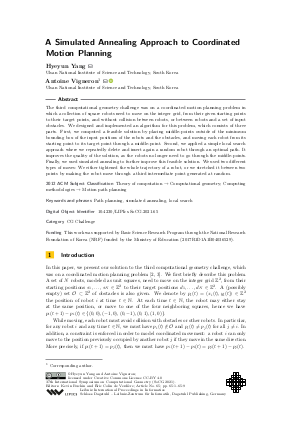A Simulated Annealing Approach to Coordinated Motion Planning (CG Challenge)
Authors
Hyeyun Yang,
Antoine Vigneron 
-
Part of:
Volume:
37th International Symposium on Computational Geometry (SoCG 2021)
Part of: Series: Leibniz International Proceedings in Informatics (LIPIcs)
Part of: Conference: Symposium on Computational Geometry (SoCG) - License:
 Creative Commons Attribution 4.0 International license
Creative Commons Attribution 4.0 International license
- Publication Date: 2021-06-02
File

PDF
LIPIcs.SoCG.2021.65.pdf
- Filesize: 0.67 MB
- 9 pages
Document Identifiers
Subject Classification
ACM Subject Classification
- Theory of computation → Computational geometry
- Computing methodologies → Motion path planning
Keywords
- Path planning
- simulated annealing
- local search
Metrics
- Access Statistics
-
Total Accesses (updated on a weekly basis)
0Document
0Metadata
Abstract
The third computational geometry challenge was on a coordinated motion planning problem in which a collection of square robots need to move on the integer grid, from their given starting points to their target points, and without collision between robots, or between robots and a set of input obstacles. We designed and implemented an algorithm for this problem, which consists of three parts. First, we computed a feasible solution by placing middle-points outside of the minimum bounding box of the input positions of the robots and the obstacles, and moving each robot from its starting point to its target point through a middle-point. Second, we applied a simple local search approach where we repeatedly delete and insert again a random robot through an optimal path. It improves the quality of the solution, as the robots no longer need to go through the middle-points. Finally, we used simulated annealing to further improve this feasible solution. We used two different types of moves: We either tightened the whole trajectory of a robot, or we stretched it between two points by making the robot move through a third intermediate point generated at random.
Cite As Get BibTex
Hyeyun Yang and Antoine Vigneron. A Simulated Annealing Approach to Coordinated Motion Planning (CG Challenge). In 37th International Symposium on Computational Geometry (SoCG 2021). Leibniz International Proceedings in Informatics (LIPIcs), Volume 189, pp. 65:1-65:9, Schloss Dagstuhl – Leibniz-Zentrum für Informatik (2021)
https://doi.org/10.4230/LIPIcs.SoCG.2021.65
BibTex
@InProceedings{yang_et_al:LIPIcs.SoCG.2021.65,
author = {Yang, Hyeyun and Vigneron, Antoine},
title = {{A Simulated Annealing Approach to Coordinated Motion Planning}},
booktitle = {37th International Symposium on Computational Geometry (SoCG 2021)},
pages = {65:1--65:9},
series = {Leibniz International Proceedings in Informatics (LIPIcs)},
ISBN = {978-3-95977-184-9},
ISSN = {1868-8969},
year = {2021},
volume = {189},
editor = {Buchin, Kevin and Colin de Verdi\`{e}re, \'{E}ric},
publisher = {Schloss Dagstuhl -- Leibniz-Zentrum f{\"u}r Informatik},
address = {Dagstuhl, Germany},
URL = {https://drops.dagstuhl.de/entities/document/10.4230/LIPIcs.SoCG.2021.65},
URN = {urn:nbn:de:0030-drops-138649},
doi = {10.4230/LIPIcs.SoCG.2021.65},
annote = {Keywords: Path planning, simulated annealing, local search}
}
Author Details
Funding
This work was supported by Basic Science Research Program through the National Research Foundation of Korea (NRF) funded by the Ministry of Education (2017R1D1A1B04036529).
References
- Loïc Crombez, Guilherme D. da Fonseca, Yan Gerard, Aldo Gonzalez-Lorenzo, Pascal Lafourcade, and Luc Libralesso. Shadoks approach to low-makespan coordinated motion planning. In 37th International Symposium on Computational Geometry (SoCG 2021), volume 189 of LIPIcs, pages 61:1-61:9, 2021. URL: https://doi.org/10.4230/LIPIcs.SoCG.2021.61.
- Erik D. Demaine, Sándor P. Fekete, Phillip Keldenich, Henk Meijer, and Christian Scheffer. Coordinated motion planning: Reconfiguring a swarm of labeled robots with bounded stretch. SIAM J. Comput., 48(6):1727-1762, 2019. URL: https://doi.org/10.1137/18M1194341.
- Sándor P. Fekete, Phillip Keldenich, Dominik Krupke, and Joseph S. B. Mitchell. Computing coordinated motion plans for robot swarms: The cg:shop challenge 2021, 2021. URL: http://arxiv.org/abs/2103.15381.
- Jack Spalding-Jamieson, Paul Liu, Brandon Zhang, and Da Wei Zheng. Coordinated motion planning through randomized k-opt. In proc. 37th International Symposium on Computational Geometry, volume 189 of LIPIcs, pages 64:1-64:8, 2021. URL: https://doi.org/10.4230/LIPIcs.SoCG.2021.64.
-
Peter van Laarhoven and Emile Aarts. Simulated Annealing: Theory and Applications. Springer Netherlands, 1987.

